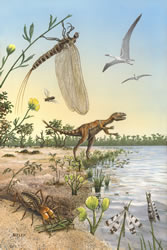In a groundbreaking new book, Fossil Insects, Faculty scientist Dr David Penney and his colleague James E Jepson  show the incredible diversity of fossilised insects around the world. Using stunning photographs and unique illustrations, the book brings to life an ancient world that was fictionalised in Jurassic Park, showing us what these fossils tell us about the ancient and modern worlds, and even the future of our planet.
show the incredible diversity of fossilised insects around the world. Using stunning photographs and unique illustrations, the book brings to life an ancient world that was fictionalised in Jurassic Park, showing us what these fossils tell us about the ancient and modern worlds, and even the future of our planet.
Using pioneering methods and state-of-the-art technology, Dr Penney has drawn on his knowledge of entomology and palaeontology to discover some astonishing new facts about these fossilised creatures. He says:
“Insects are the most diverse group of creatures on the planet today. Many of them were around even before the time of the dinosaurs. Bringing together entomology and palaeontology through the study of insect fossils has great potential for revolutionising what we know about both subjects.”
In the book, the ancient insects are brought to life by the illustrations of Richard Bizley. His drawings depict the long-vanished arthropods that lived among the flora and fauna during the time of the dinosaurs. To make the animals in his pictures look realistic, Richard created models using scientific drawings and fossils. He then photographed them to see how the light behaved. He says:
“When reconstructing fossil insect species, special attention needs to be paid to important diagnostic features, such as the wing venation patterns and the relative lengths of appendage segments. The fact that many fossil insect species are known only from isolated wings posed additional problems. This is where the collaboration with experts became very useful, and I worked closely with Dr Penney to produce an accurate reconstruction based on the comparative study of both fossil and living insects.”
While Jurassic Park may remain a fantasy, Dr Penney says that it did result in an increase in research on fossil insects. He is hoping that his book will now open up that research to an even larger audience.
